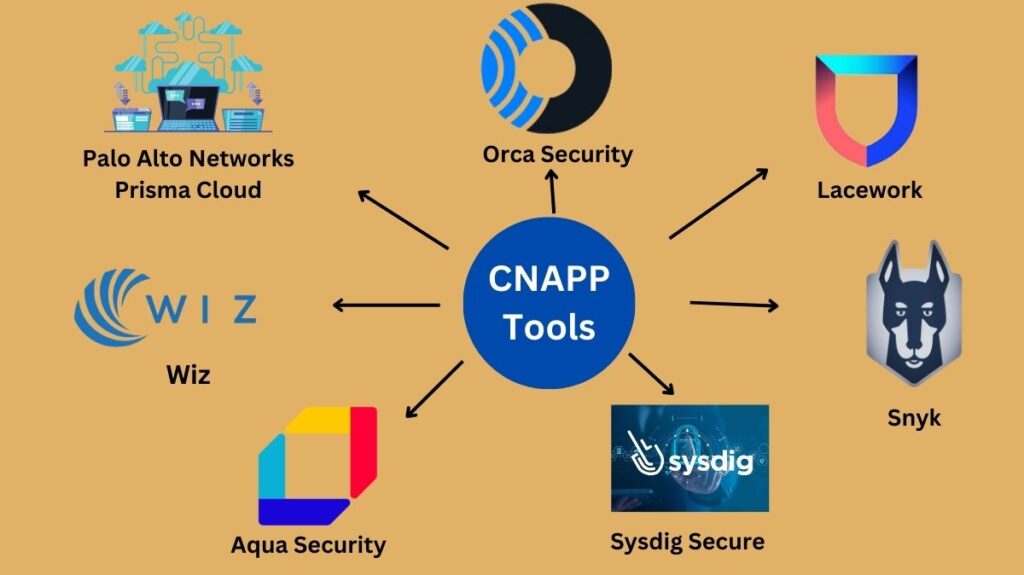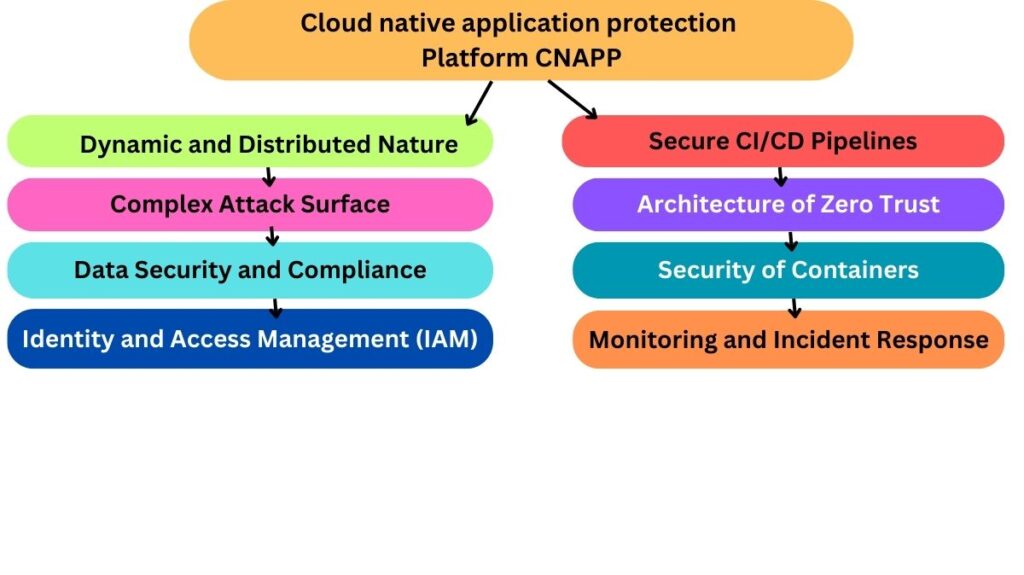CNAPP Tools

Palo Alto Networks’ Prisma Cloud
- Cloud apps with full-stack security.
- Management of security posture in multi-cloud settings.
- Workload, container, and Kubernetes threat detection and runtime protection.
- tracking and reporting on compliance.
Wiz
- Prioritising security issues according to risk.
- Visibility across identities, configurations, and workloads in the cloud.
- Ongoing evaluations of compliance.
- Connections to current CI/CD workflows.
Aqua Security
- Security for serverless workloads, Kubernetes, and containers.
- Runtime protection and image scanning.
- Firewalling and network segmentation for container environments.
- Management of vulnerabilities and compliance audits.
Security of Orcas
- Cloud asset security without agents.
- coverage of cloud services, virtual machines, and containers.
- Prioritising risks with context awareness.
- Monitoring in real time and identifying anomalies.
Lacework
- Automatic threat hunting and anomaly detection.
- Security for serverless systems, containers, and Kubernetes.
- Regulatory framework compliance management (e.g., PCI DSS, SOC 2).
- Insight on the behaviour of applications and user activity.
Snyk
- Security for cloud-native apps that is developer-focused.
- Checking for vulnerabilities in containers, open-source dependencies, and infrastructure-as-code, or IaC.
- Close connections to Git repositories and DevOps pipelines.
- Automated corrections and developer direction.
Sysdig Secure
- Threat detection and runtime security for Kubernetes and containers.
- Scanning images and managing vulnerabilities.
- Auditing and reporting on compliance.
- Falco-based runtime security engine that is open source.
Cloud native application protection Platform Challenges
Because of the distinct design and characteristics of cloud environments, Cloud Native Application Protection Platform(CNAPP) presents a number of difficulties. Important challenges include:

Dynamic and Distributed Nature
Microservices, containers, and serverless functions all of which are subject to change are frequently used in the development of cloud-native systems. This makes it challenging to ensure uniform security across different environments and components.
Complex Attack Surface
The attack surface grows with cloud services, Kubernetes, and containers. Protecting every point of entry and making sure that flaws in one component don’t impact others are challenging tasks.
Data Security and Compliance
It can be difficult to manage sensitive data across cloud services and guarantee adherence to data protection laws (such as the CCPA, GDPR, etc.), particularly in multicloud settings. Data sovereignty, access control, and encryption must be given top priority.
Identity and Access Management (IAM)
Fine-grained access control is necessary for users, apps, and services in cloud-native environments. It can be difficult to manage identities and permissions across several platforms and services, and errors might result in unwanted access.
Secure CI/CD Pipelines
Continuous integration and continuous deployment (CI/CD) are frequently used in cloud-native apps. It is essential to make sure that these pipelines are protected from malicious code injections, incorrect setups, and corrupted dependencies.
Architecture of Zero Trust
Cloud-native settings reduce the effectiveness of traditional perimeter-based security solutions. Significant adjustments to security procedures are necessary to implement a Zero Trust architecture, in which every request is validated and trust is never assumed.
Security of Containers
Security issues brought about by containers include runtime vulnerabilities, vulnerabilities in container images, and improperly configured container orchestrators like Kubernetes. It is crucial to make sure that vulnerability scanning, security policies, and container isolation are done correctly.
Monitoring and Incident Response
It can be challenging to identify security risks in a dispersed, transient setting. In order to promptly detect and address possible issues, cloud-native apps frequently need sophisticated monitoring, logging, and alerting systems.
Cloud native application protection Platform Features
A variety of functionalities are offered by cloud-native application protection platforms (CNAPPs) and associated products in order to address the security issues that contemporary cloud-native applications present. Among these features are:
Workload and Application Security
Protection at Runtime
Keeps an eye on programs while they’re running in order to identify and stop risks including code injections, privilege escalation, and illegal access.
Scanning the workload:
Scans virtual machines, containers, and serverless functions for malware, vulnerabilities, and configuration errors.
Dependency and Image Scanning
Checks for vulnerabilities in third-party dependencies and container images prior to deployment.
Security of Identity and Access Management (IAM)
RBAC, or role-based access control
Applies least privilege access rules to apps, services, and users.
Identity Threat Detection
Detects and warns about irregularities in access patterns, such as privilege escalation or illegal access.
Security of Networks
Microsegmentation
Divides network traffic across application components to prevent lateral movement.
Monitoring East-West Traffic
looks for questionable trends and possible attacks in internal traffic.
Control of Ingress/Egress
controls the flow of data into and out of the cloud environment.
Threat Detection and Response
Behavioural analysis
Finds possible threats by identifying unusual activity in workloads and apps.
Response to Incidents Automatically
Automates processes such as isolating impacted resources, stopping compromised containers, and blocking malicious IPs.
Threat Intelligence Integration
Identifies new dangers by using real-time threat intelligence feeds.
Strategies for Implementing CNAPP
To guarantee that a CNAPP is in line with the organization’s security objectives and seamlessly integrates with current workflows, careful planning and execution are necessary before implementation. Simplified security operations, enhanced visibility, and proactive risk management across cloud environments are made possible by a successful CNAPP deployment.
Assessment and Planning
Assessing the existing cloud infrastructure, detecting security flaws, and creating an execution plan are the main objectives of the first stage of CNAPP deployment.
Assessment of the Cloud Environment
Businesses need to evaluate their cloud infrastructure, including the cloud workloads they use, the providers they interact with, and the tools they already have. A baseline of the environment’s complexity, important resources, and data flows is provided by evaluation.
Identification of Security Gaps
A thorough security audit finds blind spots, overly permissive settings, vulnerabilities, and misconfigurations throughout the cloud ecosystem. Whether in workload protection, API security, or misconfiguration management, gap analysis assists in identifying the areas where CNAPP can offer the greatest benefit.
Creating a Roadmap
Security leaders provide a detailed implementation roadmap using the evaluation’s findings. In order to minimise disturbance during the rollout, the plan connects deployment schedules with business objectives and contains priorities for each component.
Deployment and Integration
Configuring the CNAPP across cloud environments and integrating it with the company’s current tools and procedures are part of the deployment phase.
Considerations for Multicloud Implementation
Numerous businesses use a variety of cloud providers, each with unique security needs and setups. The implementation of CNAPPs must guarantee uniform protection across all cloud platforms without adding complications or disputes.
Connectivity with Current Security Instruments
CNAPPs must smoothly interface with current technologies, including identity management systems, endpoint detection and response (EDR) tools, and security information and event management (SIEM) platforms, in order to optimise value. A single security approach, coordinated threat responses, and data exchange are all made possible via integration.
Enhancement of Performance
Performance and security must be balanced when deploying Cloud Native Application Protection Platform(CNAPP). To provide real-time visibility without sacrificing cloud performance, organisations must optimise agent less scanning and properly design agent-based monitoring to prevent resource bottlenecks.
Constant Improvement
Continuous optimisation is necessary for security in cloud-native environments in order to adjust to new threats and changing cloud environments.
Frequent Evaluations of Security Posture
Assessing the organisation’s cloud security posture on a regular basis is essential to continuous improvement. CNAPPs facilitate ongoing monitoring and modifications by assisting organisations in tracking metrics including the quantity of misconfigurations, open vulnerabilities, and compliance gaps over time.
Including Threat Intelligence
Integrating CNAPPs with external threat intelligence streams increases their efficacy. Integration keeps the environment safe from the most recent attacks by enabling the platform to identify new threats and automatically modify rules to address them.
Adjusting to Changing Cloud Environments
New workloads, architectures, and services are frequently added to cloud systems, which are dynamic. Businesses need to make sure that their CNAPP develops with these developments, growing with new workloads and modifying security guidelines to account for new threats, such those related to expanding APIs or AI-based services.
Read more on Cloud-Native Application Protection Platforms Advantages
